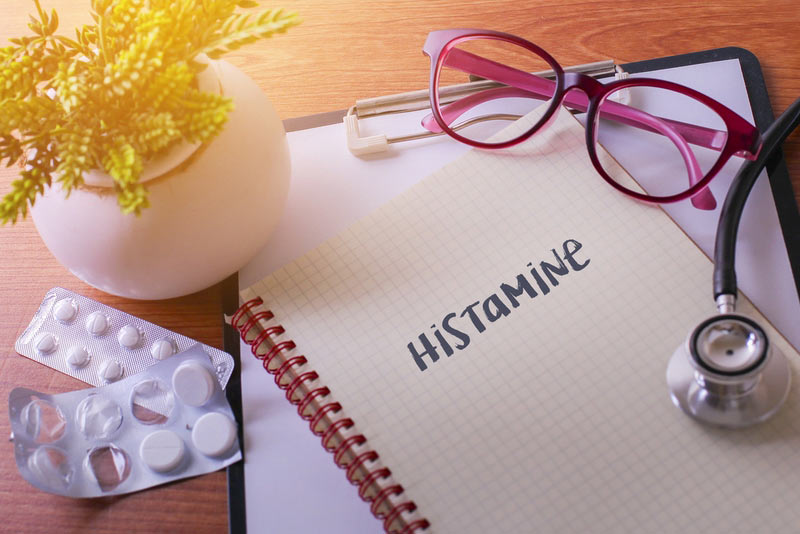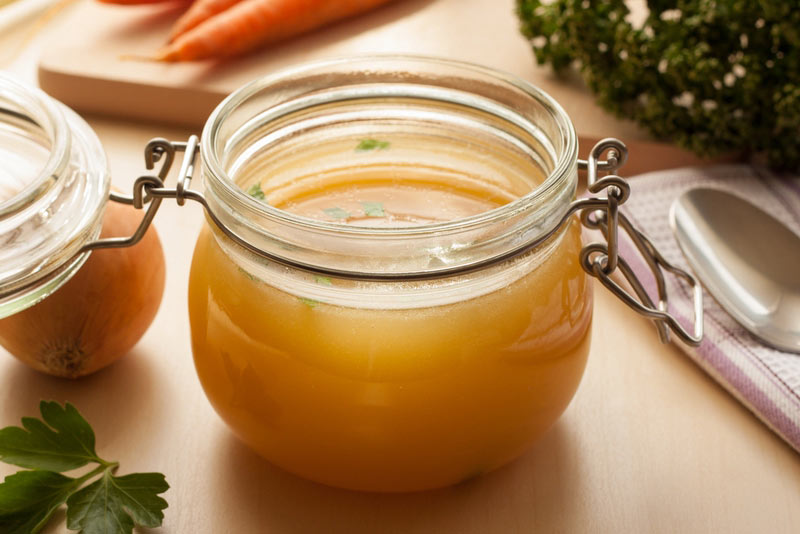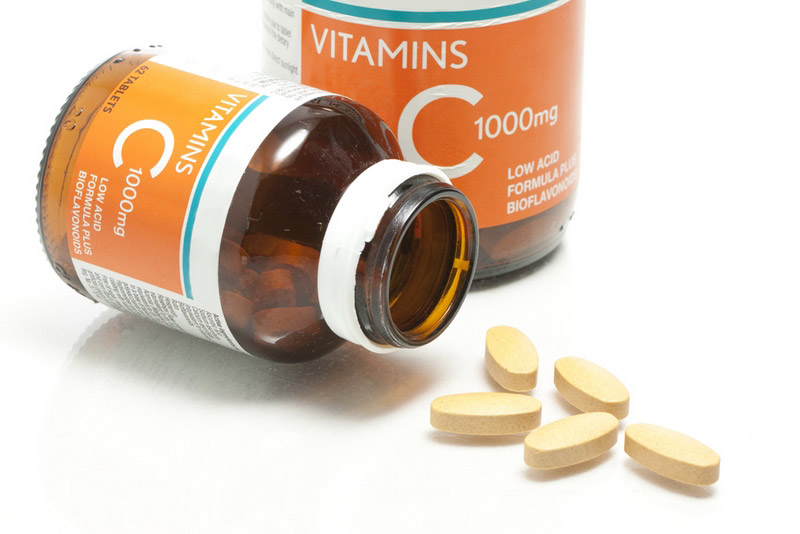21 Symptoms of Histamine Intolerance and Foods to Avoid

Histamine intolerance is not an allergy to histamine itself, but a sign that the body has too much histamine. Histamine, a chemical messenger in the body that works as a neurotransmitter, helps digest food in the stomach, and gets released by the immune system as part of an allergic response. (1) When the body accumulates too much histamine, it interferes with normal functions in the body and can lead to unpleasant symptoms.
When histamine is produced in the body, an enzyme is also made to help break it down. This enzyme is known as DAO, or diamine oxidase. When you eat foods that contain histamines, DAO is there to help break it down. If your body is unable to produce DAO and you can no longer break down histamine, an intolerance can occur. (2)
Histamine intolerances can happen for a few reasons: (3, 4, 5)
- Certain foods can block DAO from working or can cause an excess of histamine to be released.
- Some medications can change the way that DAO works, reduce levels, or increase histamines.
- Digestive, gut, and bowel disorders (like leaky gut, SIBO, IBD, etc.) can block DAO or cause an overproduction of histamine.
Histamine intolerance must be medically diagnosed. This can be determined via a blood test to check for DAO deficiency or through a skin prick test to check for reactivity to histamine. (6)
To address histamine issues, elimination diets are recommended. These avoid all sources of foods that block DAO or increase histamine production. After the elimination period, typically 14 to 30 days, foods are reintroduced one at a time to gauge reactions. This can also be a non-invasive way that doctors can diagnose histamine problems.
21 Symptoms of Histamine Intolerance

The following symptoms are associated with histamine intolerance: (7, 8, 9, 10)
- Nasal congestion or drip
- Watery eyes
- Runny nose
- Sinus issues and infections
- Headaches
- Migraines
- Nausea
- Vomiting
- Diarrhea
- Fatigue
- Hives
- Skin irritation
- Itching
- Eczema
- Digestive issues
- Abdominal cramping
- Menstrual cycle problems
- Swelling in tissues
- Anxiety
- High blood pressure
- Flushing
While these symptoms can be associated with other conditions, they’re often a result of histamine dysregulation in the body. They can happen in children and adults.
The Low Histamine Diet

A low histamine diet is used as part of an elimination diet to identify histamine sensitivities, and then to manage them until levels normalize in the body. Low histamine diets are not meant to be followed long term. Most people discover certain histamine foods that they’re sensitive to and will avoid those, but will be able to add other foods back.
Children should not be placed on low histamine diets unless done under the supervision of a doctor, since it restricts food in a more extreme way.
A low histamine diet focuses on foods that do not produce histamine in the body and that do not suppress DAO activity. There is no such thing as a histamine-free diet, since histamines are in all foods. However, by focusing on a diet low in histamines and DAO blockers, the body may be able to calm its reactivity to histamines.
Low histamine foods to eat on this plan include:
- Fresh, wild-caught seafood
- Fresh meat that is cooked; if leftover, it should be refrigerated quickly after cooking
- All fruits except citrus, strawberries, and bananas
- All vegetables except tomatoes, avocado, spinach, and eggplant
- Quinoa (note: quinoa is not Paleo)
- Rice
- Coconut milk
- Almond milk
- Olive oil
High Histamine Foods

When following a low histamine diet, it’s important to eliminate high histamine foods and those that block DAO. These include:
- Alcohol
- Fermented foods or beverages, like kombucha and sauerkraut
- Smoked meats and deli meats
- Citrus fruits
- Bananas
- Dried fruits
- Papaya
- Pineapple
- Strawberries
- Peanuts
- Eggs
- Nuts, especially walnuts and cashews
- Avocado
- Eggplant
- Spinach
- Tomatoes
- Shellfish
- Cheese
- Beans
- Soy sauce and soy products
- Chocolate
- Pickles
- Food dyes, preservatives, and additives
- Black tea
- Green tea
- Yerba mate tea
- Energy drinks
- Frozen, salted, or canned fish
- Vinegar
- Ketchup
3 Natural Ways to Lower Histamine Levels
When you’re following a low histamine diet and trying to uncover the root cause of symptoms, follow these steps to make your program more effective.
1. Keep a health journal.

Keeping a health journal during an elimination diet is vital so that you can note how you feel as you eliminate foods and, most importantly, how you feel when you add specific foods back in as a challenge. Without noting this, your elimination diet will be unproductive.
Keep in mind that most food sensitivity symptoms will appear within minutes to as long as three days, which is why a journal comes in handy. You and your practitioner will be able to note sensitivity patterns in relation to diet, medication, supplements, and other environmental factors.
In your food journal, record your daily meals, supplements, medication, beverages, activity level, sleep. Also note any other markers you track: blood glucose, blood pressure, pulse, headaches, digestive symptoms, etc. Even noting energy levels and mood can be helpful diagnostic clues. It’s also important to keep detailed notes about your urine output and bowel movements. This includes quantity and description (color, size, shape/formation).
2. Focus on healing the gut.

Since a large amount of histamine is produced in the gut, histamine reactions can often be exacerbated by leaky gut, SIBO, or other digestive problems. A gut-healing protocol can help to restore balance.
The problem with histamine intolerance is that many typical gut-friendly foods, like fermented foods, are high in histamines and may cause more irritation. Instead of eating these, focus on gut-building protocols that aren’t on the histamine avoid list. These include:
- Collagen powder
- Bone broth, preferably freshly made
- Glutamine supplements
- Probiotics that are soil-based
3. Take natural antihistamines.

Certain vitamins and minerals can help the body better handle histamine and can also boost DAO function. These also come with far fewer side effects than actual antihistamines, which can suppress digestive function and cause gut imbalance. While you should never disregard a doctor’s recommendation to take antihistamines, ask them for natural alternatives and if they might work for you.
Natural antihistamines include:
Vitamin C: A natural histamine blocker and reducer in the body, vitamin C also works as an antioxidant and can help to fight inflammation associated with histamine problems. Expert dosage recommendations for histamine lowering are 2 grams daily in the morning or in divided doses. (11)
Quercetin: Another antioxidant supplement, quercetin is found in foods like apples, onions, and broccoli. Research shows that when taken in concentrated supplement forms, it has natural antihistamine properties. (12) It can even reduce lung-related symptoms of allergies. (13)
Stinging Nettle: A common herb, stinging nettle works as a natural antihistamine and alleviates symptoms as quickly as some over-the-counter antihistamines. (14, 15)
Bromelain: A proteolytic enzyme found in pineapples, bromelain can help reduce inflammation and irritation associated with histamine overproduction. (16) It can effectively reduce swelling in nasal passages as a result of irritation from allergies. (17)
Bottom Line
Histamine intolerance can occur as a result of gut problems, genetic predisposition, and a diet high in histamine-rich foods. Addressing it with a qualified practitioner and lifestyle adjustments can produce relief from symptoms like itchy skin, headaches, and digestive disturbances.
(Read This Next: 7 Easy Ways to Naturally Improve Your Digestion)
The post 21 Symptoms of Histamine Intolerance and Foods to Avoid appeared first on PaleoPlan.
from PaleoPlan https://ift.tt/2DAcgED
Entry Published : September 28, 2018 at 07:26AM
EntryContent :

Histamine intolerance is not an allergy to histamine itself, but a sign that the body has too much histamine. Histamine, a chemical messenger in the body that works as a neurotransmitter, helps digest food in the stomach, and gets released by the immune system as part of an allergic response. (1) When the body accumulates too much histamine, it interferes with normal functions in the body and can lead to unpleasant symptoms.
When histamine is produced in the body, an enzyme is also made to help break it down. This enzyme is known as DAO, or diamine oxidase. When you eat foods that contain histamines, DAO is there to help break it down. If your body is unable to produce DAO and you can no longer break down histamine, an intolerance can occur. (2)
Histamine intolerances can happen for a few reasons: (3, 4, 5)
- Certain foods can block DAO from working or can cause an excess of histamine to be released.
- Some medications can change the way that DAO works, reduce levels, or increase histamines.
- Digestive, gut, and bowel disorders (like leaky gut, SIBO, IBD, etc.) can block DAO or cause an overproduction of histamine.
Histamine intolerance must be medically diagnosed. This can be determined via a blood test to check for DAO deficiency or through a skin prick test to check for reactivity to histamine. (6)
To address histamine issues, elimination diets are recommended. These avoid all sources of foods that block DAO or increase histamine production. After the elimination period, typically 14 to 30 days, foods are reintroduced one at a time to gauge reactions. This can also be a non-invasive way that doctors can diagnose histamine problems.
21 Symptoms of Histamine Intolerance

The following symptoms are associated with histamine intolerance: (7, 8, 9, 10)
- Nasal congestion or drip
- Watery eyes
- Runny nose
- Sinus issues and infections
- Headaches
- Migraines
- Nausea
- Vomiting
- Diarrhea
- Fatigue
- Hives
- Skin irritation
- Itching
- Eczema
- Digestive issues
- Abdominal cramping
- Menstrual cycle problems
- Swelling in tissues
- Anxiety
- High blood pressure
- Flushing
While these symptoms can be associated with other conditions, they’re often a result of histamine dysregulation in the body. They can happen in children and adults.
The Low Histamine Diet

A low histamine diet is used as part of an elimination diet to identify histamine sensitivities, and then to manage them until levels normalize in the body. Low histamine diets are not meant to be followed long term. Most people discover certain histamine foods that they’re sensitive to and will avoid those, but will be able to add other foods back.
Children should not be placed on low histamine diets unless done under the supervision of a doctor, since it restricts food in a more extreme way.
A low histamine diet focuses on foods that do not produce histamine in the body and that do not suppress DAO activity. There is no such thing as a histamine-free diet, since histamines are in all foods. However, by focusing on a diet low in histamines and DAO blockers, the body may be able to calm its reactivity to histamines.
Low histamine foods to eat on this plan include:
- Fresh, wild-caught seafood
- Fresh meat that is cooked; if leftover, it should be refrigerated quickly after cooking
- All fruits except citrus, strawberries, and bananas
- All vegetables except tomatoes, avocado, spinach, and eggplant
- Quinoa (note: quinoa is not Paleo)
- Rice
- Coconut milk
- Almond milk
- Olive oil
High Histamine Foods

When following a low histamine diet, it’s important to eliminate high histamine foods and those that block DAO. These include:
- Alcohol
- Fermented foods or beverages, like kombucha and sauerkraut
- Smoked meats and deli meats
- Citrus fruits
- Bananas
- Dried fruits
- Papaya
- Pineapple
- Strawberries
- Peanuts
- Eggs
- Nuts, especially walnuts and cashews
- Avocado
- Eggplant
- Spinach
- Tomatoes
- Shellfish
- Cheese
- Beans
- Soy sauce and soy products
- Chocolate
- Pickles
- Food dyes, preservatives, and additives
- Black tea
- Green tea
- Yerba mate tea
- Energy drinks
- Frozen, salted, or canned fish
- Vinegar
- Ketchup
3 Natural Ways to Lower Histamine Levels
When you’re following a low histamine diet and trying to uncover the root cause of symptoms, follow these steps to make your program more effective.
1. Keep a health journal.

Keeping a health journal during an elimination diet is vital so that you can note how you feel as you eliminate foods and, most importantly, how you feel when you add specific foods back in as a challenge. Without noting this, your elimination diet will be unproductive.
Keep in mind that most food sensitivity symptoms will appear within minutes to as long as three days, which is why a journal comes in handy. You and your practitioner will be able to note sensitivity patterns in relation to diet, medication, supplements, and other environmental factors.
In your food journal, record your daily meals, supplements, medication, beverages, activity level, sleep. Also note any other markers you track: blood glucose, blood pressure, pulse, headaches, digestive symptoms, etc. Even noting energy levels and mood can be helpful diagnostic clues. It’s also important to keep detailed notes about your urine output and bowel movements. This includes quantity and description (color, size, shape/formation).
2. Focus on healing the gut.

Since a large amount of histamine is produced in the gut, histamine reactions can often be exacerbated by leaky gut, SIBO, or other digestive problems. A gut-healing protocol can help to restore balance.
The problem with histamine intolerance is that many typical gut-friendly foods, like fermented foods, are high in histamines and may cause more irritation. Instead of eating these, focus on gut-building protocols that aren’t on the histamine avoid list. These include:
- Collagen powder
- Bone broth, preferably freshly made
- Glutamine supplements
- Probiotics that are soil-based
3. Take natural antihistamines.

Certain vitamins and minerals can help the body better handle histamine and can also boost DAO function. These also come with far fewer side effects than actual antihistamines, which can suppress digestive function and cause gut imbalance. While you should never disregard a doctor’s recommendation to take antihistamines, ask them for natural alternatives and if they might work for you.
Natural antihistamines include:
Vitamin C: A natural histamine blocker and reducer in the body, vitamin C also works as an antioxidant and can help to fight inflammation associated with histamine problems. Expert dosage recommendations for histamine lowering are 2 grams daily in the morning or in divided doses. (11)
Quercetin: Another antioxidant supplement, quercetin is found in foods like apples, onions, and broccoli. Research shows that when taken in concentrated supplement forms, it has natural antihistamine properties. (12) It can even reduce lung-related symptoms of allergies. (13)
Stinging Nettle: A common herb, stinging nettle works as a natural antihistamine and alleviates symptoms as quickly as some over-the-counter antihistamines. (14, 15)
Bromelain: A proteolytic enzyme found in pineapples, bromelain can help reduce inflammation and irritation associated with histamine overproduction. (16) It can effectively reduce swelling in nasal passages as a result of irritation from allergies. (17)
Bottom Line
Histamine intolerance can occur as a result of gut problems, genetic predisposition, and a diet high in histamine-rich foods. Addressing it with a qualified practitioner and lifestyle adjustments can produce relief from symptoms like itchy skin, headaches, and digestive disturbances.
(Read This Next: 7 Easy Ways to Naturally Improve Your Digestion)
The post 21 Symptoms of Histamine Intolerance and Foods to Avoid appeared first on PaleoPlan.
via IFTTT
No comments: